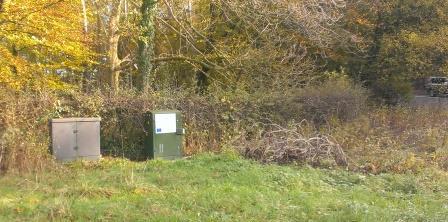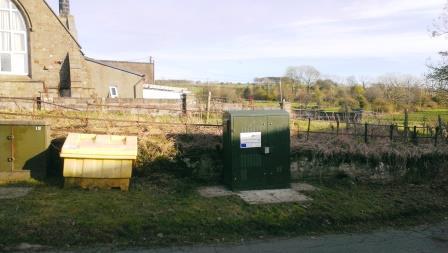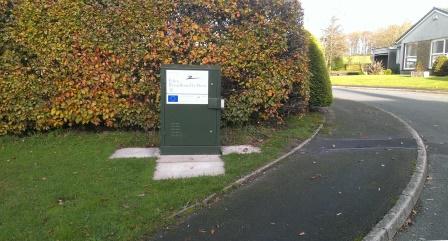-
07540 274737
Fibre Optic Internet



There are three ways in which the internet may be connected to the user over the telephone line.
1. A few years ago, the only method was to use a dial-up modem, which connected by using the voice circuit of the telephone line to send data over the line by musical notes. This tied up the line so that voice calls could not be made at the same time and it was VERY slow.
2. Faster internet was then made possible by using a system called 'Asymetric Digital Subscriber Line' (ADSL). This uses musical tones, but at a very much higher pitch than a dial up modem, and allows much greater speed of data transmission. It can also be superimposed on a line so that normal telephone use can carry on at the same time. The musical notes used are way beyond the range of human hearing. The problem is that the tones used are so high in pitch, that the telephone line saps away the signal to the extent that after a few miles of wire they are hardly usable and the internet connection becomes slow.
3. Villages like ours, which are a few miles from the telephone exchange in Cockermouth cannot get as fast a connection as those customers in the town by using the basic ADSL connection. This this is overcome by placing a special street cabinet in the village. In Tallentire it is on the corner at the Cockermouth end of the village. In Dovenby it is on the corner opposite the M-Sport entrance. In Bridekirk it is on the grass verge in the centre of the village.
What the box does is to move the exchange internet equipment closer to the user.
A new fibre street cabinet is installed near to the conventional street cabinet, and this new street cabinet is connected to the BT exchange with a fibre-optic cable which allows a high speed data connection back to the Cockermouth telephone exchange.
The broadband equipment previously housed in the exchange (known as the Digital Subscriber Line Access Multiplexer or DSLAM), is now located in the new street cabinet. In effect, the BT exchange has moved to the street cabinet and the signal loss along the copper cable between the exchange and the conventional street cabinet has been avoided.
It still makes use of the copper wires between the street cabinet and the house. However, the distances involved are much shorter than the original copper cabling all the way back to the Cockermouth BT exchange. As a result, very significant speed improvements are achieved. Even in the town, the cabinets are being placed in the streets to give fast internet speeds.
So, that's how it works. Every user should be able to achieve an internet speed up to 20 times or more faster than their old ADSL speed. The equipment is owned and maintained by BT, but they rent the use of it to other suppliers such as Sky, Plusnet, TalkTalk and various others. BT market their fast internet service as 'BT Infinity', though other suppliers may refer to it slightly differently. It is often referred to as 'Fibre Optic Internet', though some may say that this is not strictly correct because the fibre optic cable does not lead straight to the house. Another technology called 'Fibre to the Premises' (FTTP) which does connect extremely fast is available in some places. At present this is mainly used by commercial premises.
It has recently been announced by OFCOM that they wish to see Fibre to the Premises being greatly extended to residential users systems in the fairly near future. This will probably result in internet speeds of 1 gigabit per second (1024 megabits per second) instead of the current approx 50 megabits per second of current 'fibre' connections.
It would seem that FTTP has recently become available in some areas connected to the Cockermouth area telephone fibre cabinets. Some properties in Tallentire have now been directly connected to Fibre Optic cable into the house, giving them the potential to have very fast internet connection at up to 100 times the basic internet speed.
Hopefully the provision of this FTTP system will become the standard in the way that it is becoming in many European countries, though observations in other countries show that this is being achieved by overhead fibre optic cabling instead of the predominant, but more expensive, underground cabling used in the UK, at least as far a pole near to the house or commercial premises.
You will need to order the fast internet connection from your supplier. It will not happen automatically.
It is proposed by Ofcom, and supported by the industry, that the whole telephone network in the UK will be completely turned upside down by 2025. The intention is that the telephone system will be entirely internet based, with no phones of the traditional wire based type. It would seem that some of us will have fibre optic cables to our homes, though most will simply be provided free of charge with a new router with a socket to connect a traditional telephone. I think it unlikely that an old clockwork dial type phone will be supported.
This will involve every property having an internet router, even if they do not at present subscribe to an internet connection. There will still be no actual connection to the full internet without subscribing.
It will have been noticed in 2024, that work is proceeding to connect premises over the whole area directly to fibre optic cabling, which should allow a faster connection to users. Another reason, which is possibly more important, is that the hundreds of thousands of miles of copper wires in telephone cables can be replaced by thin fibre optic cables. The old copper cables are a continual maintenance problem due to failing joints and even theft of the valuable copper in those cables. The removed cables will be a valuable recycling resource.
Local residents are now being offered a fully fibre optic connection via the new network being installed by Fibrus as part of a £108 million government contract. .
Eventually the whole network will be replaced by this 21st century solution.